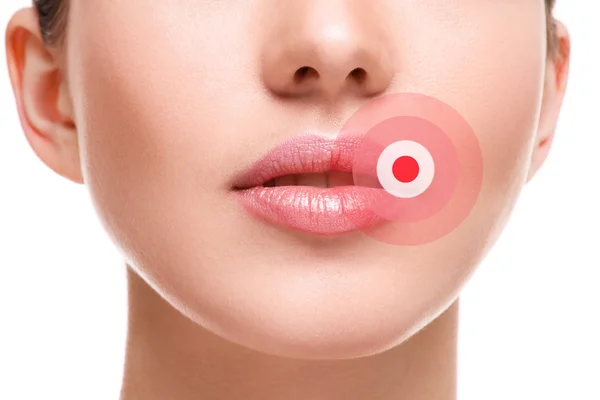
Cold sores are painful, blister-like lesions that usually appear around the lips. They are caused by the highly contagious herpes simplex virus (HSV-1). These outbreaks can be socially uncomfortable and impact daily life and self-esteem. In recent discussions, the use of a pimple patch on cold sore has emerged as a potential method for managing these outbreaks discreetly and effectively.
Traditional treatments for cold sores focus on managing symptoms and speeding up healing. However, an unconventional remedy has been gaining popularity: pimple patches, specifically hydrocolloid patches.
Originally designed for acne treatment, these patches offer a potential solution for cold sores. They create a moist healing environment that absorbs excess fluid and protects against bacteria. This method is growing in popularity due to its ease of use and discreet nature.
As more individuals seek alternative treatments, it is important to explore the effectiveness of using a pimple patch on cold sore outbreaks. Understanding how these patches work may help manage cold sore symptoms more efficiently.
Understanding Cold Sores
Cold sores, often appearing as small, blister-like lesions around the lips and face, are caused by the notorious herpes simplex virus (HSV-1). This virus is highly contagious and is typically spread through close contact such as kissing or sharing personal items like utensils. Once contracted, HSV-1 remains in the body for life, residing dormant in nerve cells until triggered to reactivate.
Outbreak Symptoms and Triggers
The onset of a cold sore is usually heralded by a tingling or itching sensation in the affected area. Following this prodrome phase, blisters form and eventually break, leaving painful sores that scab over before healing. Common symptoms during an outbreak include:
- Tingling or itching around the lips
- Blisters and sores on or near the lips
- Painful sensations when eating or drinking
Triggers that can activate an outbreak vary widely among individuals but often include:
- Stress and fatigue
- Illness, such as a cold or fever
- Hormonal changes, including those during menstruation
- Sun exposure without lip protection
Understanding these triggers and symptoms is crucial for managing cold sores effectively. While there’s no cure for HSV-1, knowing what prompts an outbreak can help in taking preventative measures.
The Role of Hydrocolloid Patches in Skin Healing
Hydrocolloid patches are innovative solutions in the realm of wound care, known for their ability to expedite the skin’s natural healing processes. These patches are crafted from materials such as gelatin, pectin, and sodium carboxymethyl cellulose, which work together to create a protective barrier over the skin.
Key Functions:
- Protection: They shield wounds from bacteria and external irritants, reducing the risk of infection.
- Absorption: These patches absorb excess fluids from the wound, which can help reduce swelling and prevent further irritation.
A significant benefit of hydrocolloid bandages is their role in creating a moist environment for healing. This moist setting is crucial as it promotes faster recovery by facilitating cell growth and maintaining a stable temperature across the affected area. In contrast to traditional dry healing methods, this moist atmosphere prevents scab formation, which can impede the healing process.
The application of hydrocolloid patches ensures that wounds remain hydrated while simultaneously managing exudate—aiding in quicker repair. It’s this unique function that has made these patches popular not only for acne treatment but also as a consideration for managing cold sores.
Interestingly, while hydrocolloid patches can be effective in treating certain types of acne, it’s important to consider other factors that may contribute to acne development. For instance, smoking weed, has been linked to hormonal changes and inflammation that could potentially worsen skin conditions.
Moreover, it’s worth noting that hydrocolloid patches are not just limited to acne treatment. They have wider applications in skincare and wound management due to their versatile nature.
Pimple Patch on Cold Sore: Understanding the Process
Mechanism of Action
Applying a pimple patch on cold sores involves leveraging the unique properties of hydrocolloid technology. These patches create a moist environment essential for healing, enabling the skin to repair itself more effectively. By absorbing exudate from the sore, they form a protective gel-like layer that shields the affected area from bacteria and other external irritants. This barrier not only helps in maintaining hygiene but also contributes to faster recovery.
The antibacterial properties of pimple patches are attributed to their ability to prevent bacterial entry, which is crucial given that cold sores can easily become infected. Although primarily designed for pimples, these patches can potentially reduce the duration of a cold sore outbreak by minimizing irritation and promoting healing.
Discreet Nature
One appealing aspect of using a discreet patch on cold sores is its inconspicuous nature. Unlike some topical treatments that can be visibly noticeable, pimple patches offer subtle coverage while providing continuous protection throughout the day. Their thin design allows them to blend seamlessly with the skin, offering users confidence without drawing unwanted attention.
The Efficacy of Hydrocolloid Patches for Cold Sores
Scientific Insights
Scientific studies have explored the efficacy of hydrocolloid patches for cold sores, comparing their performance against traditional antiviral treatments. Research suggests that these patches offer comparable healing times to medications like Acyclovir. By maintaining an optimal healing environment, they significantly reduce discomfort and accelerate recovery.
- Study Highlights:One study found that participants using hydrocolloid patches experienced similar healing durations as those using prescription antivirals.
- Another study highlighted the reduction in pain and irritation, attributing this to the patch’s ability to shield the sore from external factors.
These findings indicate that while hydrocolloid patches may not replace antiviral treatments entirely, they serve as a viable alternative or complementary option for managing cold sore outbreaks.
Understanding how pimple patches work on cold sores reveals their potential as an effective tool in combating this common viral issue. By considering their mechanism of action and examining scientific evidence, individuals can make informed decisions about incorporating these patches into their skincare routine during outbreaks.
Comparing Treatments for Cold Sores and Pimples
When it comes to using hydrocolloid patches, it’s important to understand how they work differently for cold sores and acne. Both conditions can benefit from the moist healing environment that these patches create, but the causes of each are quite different.
Treatment for Cold Sores
Cold sores are caused by the herpes simplex virus (HSV-1) and appear as blisters filled with fluid. Hydrocolloid patches for cold sores mainly aim to:
- Absorb fluid from the sore
- Create a barrier against external irritants
- Reduce discomfort and promote healing
Treatment for Acne
Acne is characterized by clogged pores, bacteria, and inflammation, which leads to pimples. In this case, pimple patches work by:
- Drawing out excess sebum and impurities
- Reducing redness and swelling
- Preventing further bacterial infection
Pimple patches are specifically designed to target these acne-related issues. The hydrocolloid material effectively absorbs pus and oil from pimples, helping to flatten them faster while protecting against picking or irritation.
Despite their similar appearance, each type of patch is tailored to address different skin challenges. While acne treatment focuses on managing bacterial growth and oil production, cold sore management emphasizes viral suppression and lesion protection. This distinction highlights the versatility of hydrocolloid technology in diverse dermatological applications.
Moreover, recent studies have shown that hydrocolloid dressings not only provide a moist environment conducive to healing but also play a significant role in accelerating the recovery process for both cold sores and acne lesions.
Pimple Patch on Cold Sore: Popular Product Recommendations
Exploring pimple patches designed for both acne and cold sores can be an enlightening journey. Many brands have ventured into creating versatile solutions that cater to different skin concerns. Here’s a look at some popular options:
- Patchology Breakout Box: This kit is a fan favorite, combining various types of patches aimed at tackling diverse skin issues. Users appreciate its multi-functional approach, ideal for those battling both acne and cold sores. The inclusion of hydrocolloid dots and salicylic acid-infused patches provides a comprehensive attack on blemishes.
- Dermalogica Deep Acne Liquid Patch: Known for its innovative formula, this liquid patch creates a breathable barrier over problem areas. While primarily designed for acne, its protective features can also support the healing of cold sores by preventing further irritation and contamination.
- Glo Skin Beauty Acne Spot Treatment: This treatment offers a targeted approach with botanical extracts and sulfur to reduce inflammation. Although mainly an acne treatment, many find it helpful in soothing cold sore discomfort due to its anti-inflammatory properties.
Each product stands out due to its unique formulation, providing users with options tailored to their specific needs. Exploring these products could be beneficial for those seeking an effective pimple patch on cold sores or acne.
Applying Hydrocolloid Patches on Cold Sores
Applying a pimple patch on a cold sore can be an effective way to manage outbreaks while promoting faster healing. Here’s a step-by-step guide to ensure you apply it correctly:
Step 1: Clean the Area
Start by gently washing the affected area with mild soap and water. Pat it dry with a clean towel to ensure no moisture remains, as this can affect the adhesion of the patch.
Step 2: Select the Right Patch
Choose a hydrocolloid patch that is appropriately sized for your cold sore. Ensure the patch covers the entire sore for optimal effectiveness.
Step 3: Apply the Patch
Peel off the patch from its backing and carefully place it over the cold sore. Press down gently around the edges to secure it in place, ensuring there are no air bubbles.
Step 4: Leave It On
Allow the patch to stay on for several hours or overnight. This creates a moist environment that aids in healing and provides a protective barrier against bacteria and irritants.
Step 5: Replace as Needed
Change the patch once it becomes opaque or starts to peel off. Continue using new patches until the sore has healed completely.
Safety Considerations
- Avoid Stretching or Pulling: When removing or applying patches, be gentle to avoid damaging sensitive skin.
- Consult Healthcare Professionals: If irritation occurs or if you have severe outbreaks, seeking advice from a healthcare provider is advisable.
- Patch Compatibility: Not all patches are suited for use on cold sores; verify product instructions before application.
Using these steps ensures that applying pimple patches on cold sores is both effective and safe, aligning with your healing goals while minimizing discomfort. It’s also worth noting that hydrocolloid dressings have been shown to significantly improve wound healing outcomes by maintaining moisture levels and providing an optimal environment for skin recovery.
Potential Limitations and Considerations
While hydrocolloid patches offer a promising alternative for managing cold sores, certain limitations of hydrocolloid patches should be considered:
- Severity of Outbreaks: In the case of severe cold sore outbreaks, these patches may not provide sufficient relief or healing. It’s crucial to assess the intensity of the outbreak and consider consulting with a healthcare professional for more potent treatments if necessary.
- Possible Side Effects: Although generally safe, some individuals might experience minor skin irritation or allergic reactions. It’s advisable to perform a patch test on another part of the skin before applying directly to a cold sore.
- Suitability for All Skin Types: Not all skin types respond well to hydrocolloid materials. Those with sensitive skin should take extra caution.
Understanding these potential limitations can help users make informed decisions when considering hydrocolloid patches as a treatment option for cold sores. Always prioritize personal comfort and health by consulting professionals when needed.
Conclusion
Exploring various remedies for cold sores, including the pimple patch on cold sore approach, can lead to effective personal care strategies. Each person’s response to treatments can vary, which highlights the importance of consulting healthcare professionals when needed. This guidance ensures that the chosen remedy aligns with personal health needs and conditions. The journey to finding cold sore remedies that work best is unique for everyone, blending traditional and innovative practices. Staying open to trying different methods while keeping professional advice in mind can lead to better management of outbreaks and improved skin health.
FAQs (Frequently Asked Questions)
What are cold sores and what causes them?
Cold sores are small, painful blisters that typically appear on or around the lips, caused by the herpes simplex virus (HSV-1). They can significantly impact individuals’ lives due to their contagious nature and the discomfort they bring.
How do hydrocolloid patches work for cold sores?
Hydrocolloid patches promote skin healing by creating a moist environment that aids in recovery. When applied to a cold sore, these patches can help protect the area from external irritants while potentially providing antibacterial properties.
Can I use a pimple patch on a cold sore?
Yes, pimple patches can be used on cold sores. They are discreet and can help in the healing process by covering the sore and keeping it protected. However, it’s important to ensure that the patch is specifically designed for such use.
Are there any scientific studies supporting the use of pimple patch on cold sore?
Yes, there have been scientific studies examining the effectiveness of hydrocolloid patches specifically for treating cold sores. These studies suggest that such patches may aid in reducing healing time and discomfort associated with outbreaks.
What should I consider when applying a pimple patch on cold sore?
When applying a pimple patch to a cold sore, ensure that the area is clean and dry before application. Follow the product instructions carefully, and consider any potential limitations or side effects of using hydrocolloid patches.
What are some popular brands of pimple patches recommended for treating cold sores?
Some popular brands that offer effective pimple patches for treating both acne and cold sores include Patchology Breakout Box, Dermalogica Deep Acne Liquid Patch, and Glo Skin Beauty Acne Spot Treatment. User experiences suggest these products may provide relief and promote healing.

